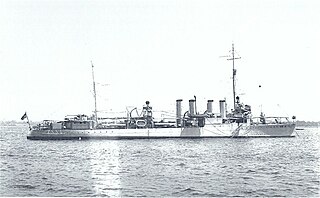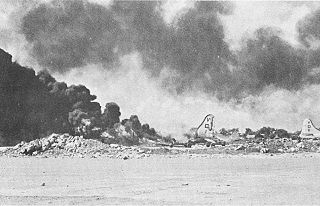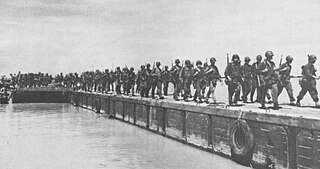
The Battle of Peleliu, codenamed Operation Stalemate II by the US military, was fought between the United States and Japan during the Mariana and Palau Islands campaign of World War II, from 15 September to 27 November 1944, on the island of Peleliu.

USS Stringham (DD–83) was a Wickes-class destroyer in the United States Navy during World War I. Later she served in World War II as APD-6. She was the second ship named for Silas Horton Stringham.

The Battle of Tinian was part of the Pacific campaign of World War II. It was fought between the United States and Japan on the island of Tinian in the Mariana Islands from 24 July until 1 August 1944. The Mariana Islands were targeted because of their location astride the Japanese line of communications. Tinian lay too close to Saipan to allow it to be bypassed and remain in Japanese hands. The 9,000-strong Japanese garrison was eliminated, and the island joined Saipan and Guam as a base for Boeing B-29 Superfortress bombers.

The Battle of Guam was the American recapture of the Japanese-held island of Guam, a U.S. territory in the Mariana Islands captured by the Japanese from the United States in the First Battle of Guam in 1941 during the Pacific campaign of World War II. The battle was a critical component of Operation Forager. The recapture of Guam and the broader Mariana and Palau Islands campaign resulted in the destruction of much of Japan's naval air power and allowed the United States to establish large airbases from which it could bomb the Japanese home islands with its new strategic bomber, the Boeing B-29 Superfortress.

The Battle of Angaur was a major battle of the Pacific campaign in World War II, fought on the island of Angaur in the Palau Islands from 17 September to 22 October 1944. This battle was part of a larger offensive campaign known as Operation Forager which ran from June to November 1944 in the Pacific Theater of Operations, and Operation Stalemate II in particular.

On 15 June 1944, United States Marine forces landed on the southwest coast of the island of Saipan in the central Marianas chain; these were followed a day later by US Army forces. This invasion was part of Operation Forager, an effort to recapture the entire Marianas chain from the Empire of Japan.

Saipan International Airport, also known as Francisco C. Ada/Saipan International Airport, is a public airport located on Saipan Island in the United States Commonwealth of the Northern Mariana Islands. The airport is owned by Commonwealth Ports Authority. Its airfield was previously known as Aslito and Isely Field.

The Pacific Ocean theater of World War II was a major theater of the Pacific War, the war between the Allies and the Empire of Japan. It was defined by the Allied powers' Pacific Ocean Area command, which included most of the Pacific Ocean and its islands, while mainland Asia was excluded, as were the Philippines, the Dutch East Indies, Borneo, Australia, most of the Territory of New Guinea, and the western part of the Solomon Islands.

The Battle of Guam was an engagement during the Pacific War in World War II, and took place from 8 December to 10 December 1941 on Guam in the Mariana Islands between Japan and the United States. The American garrison was defeated by Japanese forces on 10 December, which resulted in an occupation until the Second Battle of Guam in 1944.

USS Windsor (APA-55) was a Windsor-class attack transport in service with the United States Navy from 1943 to 1946. She was scrapped in 1972.

Sadae Inoue was a general in the Imperial Japanese Army in World War II. He commanded the Japanese forces at the Battle of Peleliu and the Battle of Angaur.
Koreans in Micronesia used to form a significant population before World War II, when most of the region was ruled as the South Seas Mandate of the Empire of Japan; for example, they formed 7.3% of the population of Palau in 1943. However, after the area came under the control of the United States as the Trust Territory of the Pacific Islands, most Koreans returned to their homeland. As of 2013, about seven thousand South Korean expatriates & immigrants and Korean Americans reside in the Marianas, which have remained under U.S. control, while only around two hundred South Korean expatriates reside in the independent countries of Micronesia.

The 18th Marine Regiment was a composite engineer regiment of the United States Marine Corps subordinate to the 2nd Marine Division. It was disbanded during the war, with the 1st and 2nd battalions remaining in the Division.

During World War II, a series of Japanese air attacks on the Mariana Islands took place between November 1944 and January 1945. These raids targeted United States Army Air Forces (USAAF) bases and sought to disrupt the bombing of Japan by Boeing B-29 Superfortress heavy bombers operating from the islands. The Japanese lost 37 aircraft during this operation, but destroyed 11 B-29s and damaged a further 43. Preparations were also made for commando raids on the bases in early and mid-1945 but these did not go ahead.

A joint assault signal company (JASCO) was a joint service unit that provided ship to shore and air to ground communications to coordinate and control naval gunfire and close air support for American land forces during World War II. They were composed of specially trained officers and enlisted personnel from the Navy, Marines, and Army. The Army component was composed of Air Liaison Officers and enlisted communications technicians. JASCOs were created in the Pacific because previous small communication teams were ineffective and only served to clutter communications. After the costly Battle of Tarawa, the need for centralized command and control of air and naval fire support between the Navy, Marines, and Army was seen. Major General Alexander Vandegrift formed the Joint Assault Signal Companies based on his experiences in the Guadalcanal campaign. Navajo and other Native American code talkers were often attached to JASCOs.
History of U.S. Marine Corps Operations in World War II is the official history of the Corps during the war. Its five volumes were published beginning in 1958.

Peleliu Naval Base was a major United States Navy sea and airbase base on Peleliu island, one of sixteen states of Palau. The United States Marine Corps took the island in the Battle of Peleliu during World War II. Battle of Peleliu was a costly conflict that started September 15, 1944, and ended November 27, 1944. On September 30, 1944, Peleliu is declared occupied. The taking of Peleliu and Morotai gave the sea and air protection needed for the later invasion of the Philippines. US Navy Seabee built a number of facilities at Peleliu Naval Base.

On 15 September 1944, United States Marine Corps forces landed on the southwestern shore of the island of Peleliu in the Palau island chain, 470 nautical miles due east of the Philippine island of Mindanao. This action, called Operation Stalemate II by American planners, was a phase in the Pacific Theatre of World War II. Whether possession of the island was necessary for the Allied cause has been the source of much controversy.

US Naval Base Marianas was a number of United States Navy bases in the Mariana Islands in the Pacific Ocean's Micronesia. Most were built by the US Navy Seabees, Naval Construction Battalions, during World War II. Naval Base Guam was lost to the Empire of Japan during the Battle of Guam in December 1941. Guam was retaken by United States Armed Forces on July 21, 1944, now also known as Liberation Day. Naval Station Guam was founded on August 7, 1899, after Spain lost the Spanish–American War.

The following is a list of resources related to the Battle of Saipan. It includes studies focused on the battle, as well as general works about the Marianas Campaign and the Pacific War that discuss the battle in depth.


















